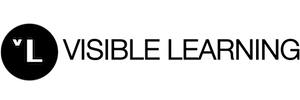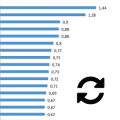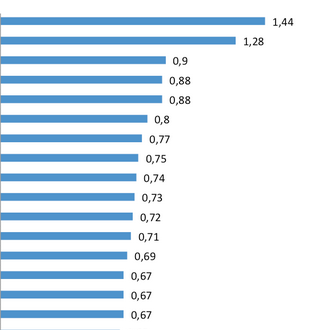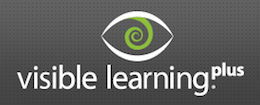
This Glossary explains influences related to student achievement published in John Hattie’s Visible Learning for teachers (Hattie 2012; 251ff). You can find an older list of influences related to student achievement in Hattie (2009) Visible Learning.
Contents
1. Student Self-Reported Grades
Self reported grades comes out at the top of all influences. Children are the most accurate when predicting how they will perform. In a video Hattie explains that if he could write his book Visible Learning for Teachers again, he would re-name this learning strategy “Student Expectations” to express more clearly that this strategy involves the teacher finding out what are the student’s expectations and pushing the learner to exceed these expectations. Once a student has performed at a level that is beyond their own expectations, he or she gains confidence in his or her learning ability.
Example for Self-reported grades: Before an exam, ask your class to write down what mark the student expects to achieve. Use this information to engage the student to try to perform even better.
Hattie cites five meta-studies:
- Mabe/West (1982): Validity of self-evaluation of ability (Abstract)
- Fachikov/Boud (1989): Student Self-Assessment in Higher Education (Abstract)
- Ross (1998): Self-assessment in second language testing (Abstract)
- Falchikov/Goldfinch (2000): Student Peer Assessment in Higher Education (Abstract)
- Kuncel/Crede/Thomas (2005); The Validity of Self-Reported Grade Point Averages, Class Ranks, and Test Scores (Abstract)
2. Piagetian programs
Piagetian programs are teaching methods based on Jean Piaget’s theory of cognitive development and his concept of children’s stages of learning. The meta-study of Jordan and Brownlee (1981) that Hattie cites found that in primary school age there is a close correlation between the performance on Piagetian tests of the thinking level and achievement tests in mathematics and reading.
The Piagetian stages include:
- Sensorimotor stage (new born – 2 years old): Infants learn by the basic senses including seeing, hearing and touching and construct an understanding of the world by coordinating those experiences with physical, motoric actions.
- Pre-operational stage (2 – 7 years old): Children are able to understand basic concepts and symbols, but do not yet understand concrete logic and cannot mentally manipulate information.
- Concrete operational stage (7-12 years old): Children in these ages start solving problems in a more logical fashion but abstract, hypothetical thinking has not yet developed.
- Formal operational stage (12 years old onwards): Children and adolescents develop abstract thinking and are able to perform hypothetical and deductive reasoning.
Watch this video to find out and see how children in different ages think differently.
Example for Piagetian programs: Focus on the thinking processes rather than the outcomes and do not impose the adult thinking process on to children.
Hattie cites one meta-study: Jordan and Brownlee (1981) Meta-Analysis of the Relationship between Piagetian and School Achievement Tests. (Abstract)
3. Response to intervention
Response to intervention (RTI) is an educational approach that provides early, systematic assistance to children who are struggling in one or many areas of their learning. RTI seeks to prevent academic failure through early intervention and frequent progress measurement. Watch this video to learn more about Response to intervention.
Examples and more information for Response to intervention: www.interventioncentral.org
4. Teacher credibility
According to Hattie teacher credibility is vital to learning, and students are very perceptive about knowing which teachers can make a difference. There are four key factors of credibility: trust, competence, dynamism and immediacy. In an interview Hattie puts it like that: “If a teacher is not perceived as credible, the students just turn off.”
Examples for teacher credibility: Earn trust by showing trust towards pupils. Appear highly organised in the presentation of the subject matter. Develop a powerful style of speaking that uses few verbal hesitancies such as “OK” or “you know”. Reduce distance between teachers and students by moving or moving away from barriers (e.g., desk, podiums). Source: cie.asu.edu
5. Providing formative evaluation
According to Hattie (2012) and Black & Wiliam (2001) formative evaluation refers to any activity used as an assessment of learning progress before or during the learning process itself. In contrast with formative assessment, the summative assessment evaluates what students know or have learned at the end of the teaching, after all is done. Watch this video to learn more about the difference between formative and summative assessment methods. In another video you can learn from teachers who describe their experience with formative evaluation.
Example for formative evaluation: Spend the same amount of time or even more on formative assessment as you spend on summative assessment. Give descriptive feedback to students: What is the goal? Where are you in relation to it? What can you do to close the gap?
Hattie cites two meta-studies:
- Fuchs & Fuchs (1986): Effects of systematic formative evaluation (Abstract)
- Burns & Symington (2002): A Meta-analysis of Prereferral Intervention Teams: Student and Systemic Outcomes (Abstract)
6. Micro-teaching
Micro-teaching is a video recording of a lesson with a debriefing. The lesson is reviewed in order to improve the teaching and learning experience. In Visible Learning Hattie describes micro-teaching as a practice (often in laboratory settings) that “typically involves student-teachers conducting (mini-) lessons to a small group of students, and then engaging in a post-discussion about the lessons” (Hattie 2009, 112). You can find plenty of microteaching videos on Youtube to get an idea of this method (example). Technical aspects are less important than the later analysis which allows teachers to get a microscope-view on your own teaching. Under the guidance of a supervisor, the student-teacher is first asked to present a self feed back of his mini lesson, then the team gives feedback to provide positive reinforcement and constructive criticism.
Examples for micro-teaching: Since its invention in the 1960s at Stanford University by Dr. Dwight Allen, microteaching has become an established teacher-training procedure in many universities and school districts. You can find more information on micro-teaching here or here.
Hattie cites four meta-studies:
- Butcher (1981) An experimental investigation of the effectiveness of a value claim strategy unit for use in teacher education (Unpublished M.A. Macquarie University Sydney)
- Yeany/Padilla (1986): Training science teachers to utilize better teaching strategies (Abstract)
- Bennett (1987): The effectiveness of staff development training practices (Unpublished Ph.D. University of Oregon)
- Metcalf, K. K. (1995). Laboratory experiences in teacher education (Abstract)
7. Classroom discussion
Classroom discussion is a method of teaching, that involves the entire class in a discussion. The teacher stops lecturing and students get together as a class to discuss an important issue. Classroom discussion allows students to improve communication skills by voicing their opinions and thoughts. Teachers also benefit from classroom discussion as it allows them to see if students have learnt the concepts that are being taught. Moreover, a classroom discussion creates an environment where everyone learns from each other. In this video by Heather Joseph-Witham you can see how to lead a classroom discussion effectively.
Examples for an effective classroom discussion: Create a series of questions for the students to think about. Allocate enough time in the lesson for an elaborate discussion. Make sure that students can freely express their opinion without being laughed at or ridiculed. You can find helpful tips on planning, moderating and reflecting on classroom discussion in a paper by William E. Cashin (PDF).
8. Comprehensive interventions for learning disabled students
The presence of learning disability can make learning to read, write, and do math especially challenging. Hattie admits that “it would be possible to have a whole book on the effects of various interventions for students with learning disabilities” (Hattie 2009, 217) and refers to a meta-study of Swanson, Hoskyn and Lee (1999). To improve achievement teachers must provide students with tools and strategies to organize themselves as well as new material; techniques to use while reading, writing, and doing math; and systematic steps to follow when working through a learning task or reflecting upon their own learning. Hattie also discusses studies which found that “all children benefited from strategy training; both ths with and those without intellectual disabilities.”
Examples for effective interventions for students with learning disabilities: One strategy discussed in a paper by Neil Sturomski: “Teaching Students With Learning Disabilities To Use Learning Strategies” (PDF) is called “DEFENDS”. This strategic approach helps secondary students write a composition in which they must take a position and defend it (Ellis, 1994). Each letter stands for a strategic step:
D ecide on audience, goals, and position
E stimate main ideas and details
F igure best order of main ideas and details
E xpress the position in the opening
N ote each main idea and supporting points
D rive home the message in the last sentence
S earch for errors and correct
You can find further information in a papber by H. Lee Swanson and Donald Deshler (2003): Instructing Adolescents with Learning Disabilities: Converting a Meta-Analysis to Practice (PDF)
9. Teacher clarity
Hattie defines teacher clarity quoting the (unpublished) work of Fendick (1990) as “organization, explanation, examples and guided practice, and assessment of student learning — such that clarity of speech was a prerequisite of teacher clarity.” (Hattie 2009, 126) One of the main points of Hattie’s books about Visible Learning is the importance to clearly communicate the intentions of the lessons and the success criteria. Clear learning intentions describe the skills, knowledge, attitudes and values that the student needs to learn. Teachers need to know the goals and success criteria of their lessons, know how well all students in their class are progressing, and know where to go next.
Examples for teacher clarity, learning goals and success criteria: This short video provides a great example for a lesson intended to let students write a good “How-to book”. The teacher explains how to develop and set clear learning goals and success criteria before the students actually start the writing activity.
Hattie cites one meta-study:
- Fendick (1990): The correlation between teacher clarity of communication and student achievement gain (Unpublished Ph.D. University of Florida)
10. Feedback
According to Hattie and Timperley (2007) feedback is one of the most powerful influences on learning and achievement, but this impact can be either positive or negative. They developed a model of effective feedback that identifies the particular properties and circumstances that make it work. Feedback on task, process and self regulation level is far more effective than on the Self-level (e.g. praise wich contains no learning information). Descriptive feedback is closely related to providing formative assessment (see above). In an interview Hattie emphasized that the most powerful feedback is that given from the student to the teacher. This feedback allows teachers to see learning through the eyes of their students. It makes learning visible and facilitates the planning of next steps. The feedback that students receive from their teachers is also vital. It enables students to progress towards challenging learning intentions and goals.
Examples: Related to the notion of “feed up, feed back and feed forward” teachers must answer three feedback questions: “Where am I going? How am I going? Where to next?” Constantly ask the students in order to maximize the feedback from the learner back to the teacher. Create a classroom climate where error is welcomed. In this short video John Hattie talks about what feedback means and how to make feedback work effectively for learning in the classroom.
Glossary by Sebastian Waack. Follow me on Twitter. Always happy to talk!






Hi Great website.
Just a couple of points re Hattie’s top-ten.
No2: Although you have correctly described Piagetian Programs, the research Hattie cites only refers to the fact that if you assess students using a Piagetian test of thinking level (not on the topic), and then give them a subject/topic test, there is a close correlation. It does not refer to the effectiveness of a Piagetian program.
No5: This is different from the feedback which comes 10th because it refers to feedback to the teacher (rather than the pupil).
Hope that helps
Mike
Dear Mike!
Thank you very much for your clarification that provides additional information for a better understanding of Hattie’s top 10. I updated the article.
Best Sebastian
Dear readers,
make sure to check out and join Mike’s Evidence based teachers network (EBTN) http://www.ebtn.org.uk
Teacher interaction is the key. As we move away from the college model of simple lecture which was the trademark of 1970’s style of teaching, we build credible classroom discussions. Students believe in teachers that are honest and forthright in their interactions with students. When we are immediate as teachers and truly care about our students and their learning we lead by positive example. Twenty-first century teaching is not about gadgets it is about building a foundation of learning with our students and by boldly leading towards a partnership of learning.
Just curious why you called #5 Formative Evaluation rather than Formative Assessment.
Also:
What is the difference between Formative Assessment and Feedback> Do they overlap? Is it just the level of formality?
From what i remember: Formative assessment is one form of feedback. It focuses on giving the student(and indirectly teacher) information on how to improve. It should come early enough so that the student has time to try and implement those changes.
The other main form of feedback is summative which sums up the knowledge of the student. Typical example would be an exam with letter grades.
Of course there is nothing wrong with overlapping both quite a bit.
Formative Evaluation involves student voice, it refers to any activity used as an assessment of learning progress before or during the learning process itself. So basically the student deciding how well or not well they are likely to go when assessed. The key is that the teacher challenges the student to exceed this.
Formative assessment is the development of teaching points for the next steps in learning based on the assessment data.
I agree with Mehmet Emir Yalvac; it should be fairly obvious that neural perception of distance, perspective and parallax will be different outdoors. Dopamine got the obligatory mention, but the authors might have followed that through by looking up information on Parkinson’s disease.
Could you please advise when the Glossary will be updated to reflect the new rankings?
As an instructional leader, I feel it is very important to present unserstanding using the results of the most recent research. The Glossary on the most recent list would b e extremely helpful. Thank you!
Providing formative evaluation was helpful for me. Engaging students, finding out where they are, and discussions on relevant topics has been a means for developing trust, and an opportunity to demonstrate fairness to everyone.
Is this site still active/updated regularly? I ask because the Glossary lists “Student Self-Reported Grades” at #1, but the 2018 list shows “Collective Teacher Efficacy” as #1.
Secondly, is it correct to assume that Hattie’s book defines what he means by each influence? For example, what does he mean by “Detracking”, “Sentence Combining Programs”, and “Desegregation” to name a few?
Dear Mike,
Thanks for your comment. I try to update this site regularly but I lag a bit behind for the Glossary.
I wrote an extra blog post on the new #1 influence here: https://visible-learning.org/2018/03/collective-teacher-efficacy-hattie/
In Hattie’s books you will gain a better understanding of most of the factors, even if there is not a definition for each influence. That’s why I started to work on the glossary. You need to dive deeper into the meta-analyses and analyses.
There is an interesting Swiss project who set up a Wiki site with a definition of 140 influences (in German only).
https://web.fhnw.ch/plattformen/hattie-wiki/begriffe/Kategorie:Faktoren
Kind regards,
Sebastian
In John Hattie’s 2017 update ‘Performance Goals’ from the ‘Student Domain’ is ranked 236 and has a ‘negative influence’: I’m interested in the definition of this… does this mean the Student(s) setting their own performance goals?
Thanks
Hattie in an interview with Ollie Lovell in 2018 -http://www.ollielovell.com/podcast/
said about ranking – “it worked then it got misleading so
i stopped it”
Just wondering what this means?
Hi,
Is there any research on adult English as Foreign Language learners and the impact of the Visible Learning program? Where could I read about experiences of VL implementation in this specific domain? Thanks!